DMF will accept carcasses at several locations
The Division of Marine Fisheries will accept flounder for the Carcass Collection and Saltwater Fishing Tournament (Citation) programs during the upcoming recreational fishing season.
The division has also set up a one-stop source for information about the 2021 recreational flounder season, which begins Sept. 1.
Carcass Collection
The division has set up five temporary locations, in addition to the nine carcass collection locations available throughout the year, where recreational fishermen can donate their flounder carcasses.
The temporary locations are:
- The Division of Marine Fisheries Elizabeth City Office
- The Department of Environmental Quality Washington Regional Office
- Seagate Marina Cleaning Station, Newport
- Chasin’ Tail Guides Dock, Atlantic Beach
- Breakday Charters Cleaning Station, Atlantic Beach
The year-round locations are (map available here):
- Cape Pointe Marina, Harkers Island
- East Side Bait and Tackle, Washington
- Frisco Rod & Gun, Frisco
- Jennette’s Pier, Nags Head
- Sea View Crab Company, Wilmington
- Tex’s Tackle, Wilmington
- Dudley’s Marina, Swansboro
- NC Division of Marine Fisheries Headquarters, Morehead City
- Marine Corps Air Station Cherry Point- Environmental Affairs Office (available only to those with military base access)
Leave head and tail intact
When cleaning the fish, anglers should leave the head and tail intact and, if possible, leave the guts in the fish. Anglers who fished on a charter boat or head boat should let the fish cleaner know the carcass will be donated.
While the catch is still fresh, take it to the nearest donation location. Instructions on how to deposit the carcasses are posted at each site. Anglers will be asked to give information related to how and when the fish was caught. Fishermen also will be asked for their names and addresses.
Division biologists will measure the fish, determine the sex, if possible, and remove the otoliths (ear bones) to determine the age of the fish. The information collected will be available for use in future flounder stock assessments.




Be the first to comment